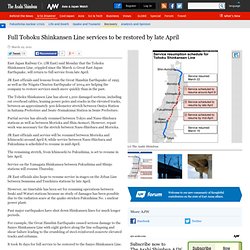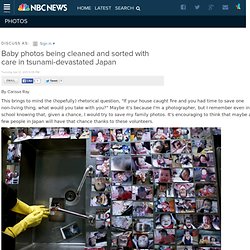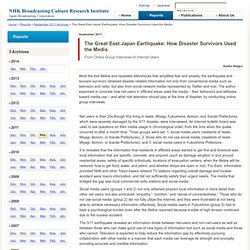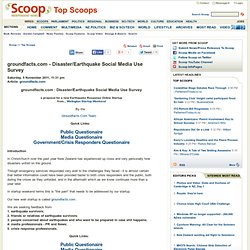

Video cpt jap. Japon (tsunami) : vagues géantes vues depuis un hélicoptère ! Mass Graves the Only Option for Many Japan Tsunami Victims. Comment l'armée japonaise fait face au séisme. Le séisme du 11 mars, suivi d’un tsunami et d’accidents nucléaires graves a mis en lumière le rôle des forces d’autodéfense japonaises, nom officiel de l'armée japonaise, dans les contextes de catastrophes naturelles et industrielles de grande ampleur.

Le Monde.fr | • Mis à jour le | Par Edouard Pflimlin Le séisme du 11 mars, suivi d’un tsunami et d’accidents nucléaires graves a mis en lumière le rôle des forces d’autodéfense japonaises (FAD), nom officiel de l'armée japonaise, dans les contextes de catastrophes naturelles et industrielles de grande ampleur. 550 000 personnes évacuées. Près de 100 000 soldats ont été mobilisés, soit 40 % des effectifs des forces d’autodéfense. Aux côtés des forces de police, des services du ministère de la santé et des pompiers, ces soldats ont évacué plus de 550 000 personnes qui ont perdu leur logement à cause du tsunami ou qui vivaient dans un rayon de 30 km autour de la centrale nucléaire de Fukushima. Une réaction rapide. Japan Earthquake: Two Months Later - In Focus. Two months ago this week, on March 11, the 9.0-magnitude earthquake and tsunami struck northeastern Japan.

As of today, nearly 15,000 deaths have been confirmed, and more than 10,000 remain listed as missing. In some coastal communities, where the ground has sunk lower than the high tide mark, residents are still adjusting to twice-daily flooding. Many thousands still reside in temporary shelters because their homes were either destroyed or lie within the exclusion zone around the damaged Fukushima Dai-ichi nuclear power plant.
Now that tourism season has arrived, Japan -- especially Fukushima prefecture -- is finding itself hit by yet another disaster: visits to the country have dropped by 50 percent. Collected below are images from the tsunami-affected areas of Japan over the past several weeks. [42 photos] Here's a Photo of Shigeru Ban's Earthquake-Relief Housing - Globe Trotting. GEOG 588: Planning GIS for Emergency Management. Basic outline: 1st paragraph (people & infrastructure during response phase) - Adrienne.

Hello » Blog Archive » Shigeru Ban: Japan Earthquake Relief. Shigeru Ban is an architectural firm in Japan that takes initiative to build and deploy cardboard partitions to displaced victims who are forced to take shelter in evacuation sites during natural disasters.

Since the 2004 Niigata earthquake, Shigeru Ban has been constantly making revisions to their partitions to better fit the needs of each crisis situation. With thousands of families seeking shelter in school gyms due to the March 11 earthquake, which also triggered tsunamis and crippled a nuclear power plant, shelter is one of Japan’s main needs. Surviving the Earthquake Aftermath in Japan - Photo Essays.
Restoring Tohoku railway lines. Railways are an important part of the infrastructure that was heavily damaged by the March 11 earthquake and tsunami.

Although major railway lines of East Japan Railway Co. (JR East), such as the Tohoku Shinkansen Line and the Tohoku Line, have resumed operations, local railway lines have not fully recovered. The central government needs to make efforts to quickly restore services on these lines because they are important means of traffic for local residents. Otherwise, people may increase their reliance on cars, thus weakening the financial basis for continued train operations. Among the railway lines in the Tohoku region operated by JR East, train runs have not been resumed on 344 km of sections on seven lines including the Hachinohe and Yamada lines.
Full Tohoku Shinkansen Line services to be restored by late April. East Japan Railway Co.

(JR East) said Monday that the Tohoku Shinkansen Line, crippled since the March 11 Great East Japan Earthquake, will return to full service from late April. Six-Month Timeline Since the Great East Japan Earthquake. International : Les Japonais face au risque de pénurie alimentaire. After Japan's earthquake and tsunami - week 5 - Slideshows and Picture Stories. Baby photos being cleaned and sorted with care in tsunami-devastated Japan. By Carissa Ray This brings to mind the (hopefully) rhetorical question, "If your house caught fire and you had time to save one non-living thing, what would you take with you?

" Maybe it's because I'm a photographer, but I remember even in school knowing that, given a chance, I would try to save my family photos. It's encouraging to think that maybe a few people in Japan will have that chance thanks to these volunteers. Toru Hanai / Reuters A volunteer cleans a family photo that was washed by the March 11 earthquake and tsunami as baby photos are placed to dry at a volunteer centre in Ofunato, Iwate prefecture, April 12, 2011. You can see David Arnott's post on the beginning of this photo recovery effort here and Meredith Birkett's post from last month on the images left in the wake of the tsunami.
A volunteer opens family photos that were washed away by the March 11 earthquake and tsunami before cleaning at a volunteer centre in Ofunato, Iwate prefecture, April 12, 2011. Japon: la chronologie des événements. Séisme, tsunami et accidents nucléaires.

Chronologie de la catastrophe. Japon: une semaine en enfer. The Great East Japan Earthquake: How Disaster Survivors Used the Media. September 2011 From Online Group Interviews of Internet Users Ayako Shigyo Amid the lost lifeline and repeated aftershocks that amplified fear and anxiety, the earthquake and tsunami survivors obtained disaster-related information not only from conventional media such as television and radio, but also from social network media represented by Twitter and mixi.

The author examined in concrete how net users in afflicted areas used the media – their behaviors and attitudes toward media use – and what role television should play at the time of disaster, by conducting online group interviews. Net users in their 20s though 40s living in Iwate, Miyagi, Fukushima, Aomori, and Ibaraki Prefectures, which were severely damaged by the 3/11 disaster, were interviewed. Welcome to IPRA - International Public Relations Association. Groundfacts.com - Disaster/Earthquake Social Media Use Survey. Groundfacts.com : Disaster/Earthquake Social Media Use Survey a proposal for a new Earthquake Response Online Startup from...

Welington Startup Weekend By the Groundfacts.Com Team. Roles of Social Media at the Time of Major Disasters Observed in the Great East Japan Earthquake: July 2011 Yumi Yoshitsugu The Great East Japan Earthquake, followed by the tsunami and the nuclear accident, turned out to be an unprecedented catastrophe. In comparison with the Great Hanshin-Awaji Earthquake that struck Japan 16 years ago, one big difference stands out in terms of information transmission; social media represented by Twitter played a certain role along with traditional media such as television and radio. The author outlines what role these social media performed in transmitting information at the latest earthquake. The Great East Japan Earthquake that hit Japan on March 11 registered a magnitude of 9.0, the largest in recorded history in Japan, and giant tsunami waves engulfed a broad area of the Pacific coast of Tohoku to Kanto regions.
The NHK Monthly Report on Broadcast Research. How the web is helping Japan to weather the storm. DIMSDRIVE Research on the earthquake. DIMSDRIVE Research are the latest company to publish the results of their survey into The Great East Japan Earthquake Disaster. Demographics Between the 25th and 28th of March 2011 9,948 members of the DIMSDRIVE Research monitor group completed a private online questionnaire. 56.4% of the sample were male, 0.6% in their teens, 6.5% in their twenties, 23.5% in their thirties, 33.7% in their forties, 21.4% in their fifties, and 14.3% aged sixty or older.
There are a number of questions related to power cuts; however, since the survey was conducted TEPCO has announced that they have got the power supply situation under control, and there will be no more scheduled power cuts, although we just have to wait and see what the summer will hold for us. Although I’m far away from the affected area, getting hold of water was the biggest problem.
Almost all the bottled water was sold out, barring the fizzy stuff like Perrier. PUBLICATION. Séisme et tsunami au Japon - Image 92 sur 96. Art imitates life: Comics reflect the world after quake. An increasing number of manga works are depicting the world after the March 11 Great East Japan Earthquake and tsunami where familiar landscapes were destroyed beyond recognition and survivors are left with uncertain futures. These manga artists seem to be coming face to face with the reality weighing heavily on their own minds. "JoJolion," the eighth story arc of the long-running series "JoJo's Bizarre Adventure" that started in the 1980s, began in the June issue of Shueisha Inc.'s monthly Ultra Jump comic magazine released in May. It is explained at the beginning of the story that the town of Moriocho has been greatly damaged by the powerful earthquake. Moriocho, which was featured in one of the "JoJo" arcs, is part of "S City. " Live Japon : la mesure du risque à portée de main.
Les mangas ont déjà dessiné le séisme. Les désastres sont un classique de la BD japonaise et sont intimement liés à l’histoire ancienne et récente de l’archipel. Un tremblement de terre de magnitude 9 suivi d’un tsunami ravageur qui emporte tout sur son passage, avec en prime la peur d’une catastrophe nucléaire de grande-ampleur. Ce n’est pas un scénario de bande-dessinée mais bien la réalité que vit le Japon en ce moment, confronté au plus important séisme de son histoire récente. Pourtant, on peut parier que l’épisode cataclysmique de ces trois derniers jours sera adapté, d’une façon ou d’une autre, en manga.
Et ce ne serait pas étonnant, puisque le thème de la destruction imprègne tous les pans de l’art japonais. Dernier exemple en date: le manga Tokyo Magnitude 8, dont la publication a commencé en France il y a deux ans. EARTHQUAKES AND LIFE IN JAPAN: PREPAREDNESS, BUILDING CODES. WARNINGS AND DRILLS. The shinkansen automatically shuts down during an earthquake Balancing on several tectonic plates, Japan is one of the most earthquake-prone countries in the world, with more than 130,000 quakes logged in 2005. Evan Osnos wrote in The New Yorker, “To geologists, earthquakes are a constant in the planet’s eternal becoming. To the Japanese, they are simply a constant. Are you in Crisis Mode? Lessons from Japan's Tohoku Earthquake. A checklist of crisis management issues relevant for every C-level hospital executive A professional colleague, Stacie DePeau, MBA, PMP, and parent extraordinaire, sent a link to me last week.
The link took me to an article that detailed how one company and its local Tokyo retail store management dealt the earthquake in Japan. Although some will be distracted by the feel-good marketing halo the story inspires, the account contains a check list of crisis management issues in narrative form that are relevant for every C-level hospital executive. And I mean every C-level exec, not just the CIOs and CMOs who own their respective crisis management plans.
Temporary housing « recovering tohoku. Solitary deaths since disaster total 97 in 3 prefectures, yomiuri, 3/20/14 As of the end of January, at least 97 people affected by the Great East Japan Earthquake in March 11, 2011, had died unattended in temporary housing units in disaster-hit Iwate, Miyagi and Fukushima prefectures, information obtained from police headquarters in the three prefectures. Long periods of evacuee life have caused many people to grow isolated or develop physical or mental problems. Local governments and social welfare organizations are taking measures to keep an eye on such people by mobilizing large numbers of staffers or installing sensors in temporary housing units. There is no precise definition of the Japanese term kodokushi, meaning “solitary death,” and police do not record statistics on such deaths. Sites/reliefweb.int/files/resources/Fullreport_0.pdf.
Tsunami: to survive from tsunami - Susumu Murata, Fumihiko Imamura, Kazumasa Katoh. Looting Rears Its Head in Japan. Les Japonais vivent dans le risque, car vivre dans ce pays, c'est un risque. (Article Revue de Presse) Earthquake Early Warning japan logo. Earthquake Early Warning FM Radio EAQ-001.jpg - Wikipedia, the free encyclopedia. Www.bupedu.com/lms/admin/uploded_article/eA.448.pdf. Namazu-e: Earthquake catfish prints. In November 1855, the Great Ansei Earthquake struck the city of Edo (now Tokyo), claiming 7,000 lives and inflicting widespread damage. Within days, a new type of color woodblock print known as namazu-e (lit. "catfish pictures") became popular among the residents of the shaken city. These prints featured depictions of mythical giant catfish (namazu) who, according to popular legend, caused earthquakes by thrashing about in their underground lairs.
In addition to providing humor and social commentary, many prints claimed to offer protection from future earthquakes. 1. The popularity of namazu-e exploded, and as many as 400 different types became available within weeks. 2. Project MUSE - The Journal of Japanese Studies - Earthquake Nation: The Cultural Politics of Japanese Seismicity, 1868-1930 (review) Www.personal.psu.edu/faculty/g/j/gjs4/Shaking_Up_Japan.pdf. Japan's Earthquake and the Hazards of an Aging Population - Alexandra Harney - International. Devastation in the Japanese countryside exposes a looming demographic crisis Much as the aftermath of Hurricane Katrina highlighted ugly realities in American society, the recent earthquake has uncovered a troubling side of Japan's national life: the vulnerability of its poor, neglected, and increasingly elderly rural countryside. No miracle that 99.8% of the schoolkids survived How the children of Kamaishi got through the tsunami WEDGE Infinity.
Japan: Living with Disasters. TSUNAMIS IN JAPAN: PREPAREDNESS, WARNINGS AND TSUNAMI STONES, Teaching of Tendenko saved lives of school children in Japan - Edu4drr. The article below is from the Daily Yomuiri online and explains how an education programme based on one word and integrated into other parts of the curriculum was effective at saving lives and enabling children and youth to know how to respond and to do so without hesitation. Humanitarian response to the 2011 Tōhoku earthquake and tsunami. 2011 Tōhoku earthquake and tsunami. Tendenko. Protective behavior and tsunami tohoku effectiveness asahi shumbun. The Effects of Tsunami on Society - by Dr. George Pararas-Carayannis - Tsunami Page of Dr.George PC.